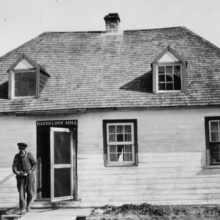Norway House
The Hudson’s Bay Company opened Norway House in 1814 at Mossy Point near Lake Winnipeg, naming their new settlement for the Norwegian axe-men hired to clear communications routes.
Norway House was responsible for production of York Boats, which served as the main mode of transport between the HBC’s inland trading posts.
A fire destroyed the original structure in 1826, and a new one rebuilt closer to Jack Lake along Lake Winnipeg. A handful of buildings still remain. Among them, a wooden-frame warehouse, and the 1855 Gaol. These remaining buildings all testify to the variety of functions local construction materials could serve. The Warehouse, built in 1839, was constructed in the Red River Frame style with nearby timber. The Gaol, meanwhile, was built in 1855 using limestone to construct sturdy exterior walls. It is a simple structure; large, rectangular, under a hipped roof, with a symmetrical façade and central doorway.
Trading and transit posts like Norway House became contact points between Indigenous peoples and European settlers and would become sites of negotiation for the Western Treaties. It was at Norway House, in 1875, that Treaty 5 was signed by the Federal Government of Canada, the Swampy Cree, and the Ojibway.









